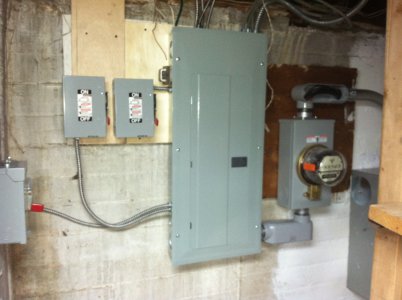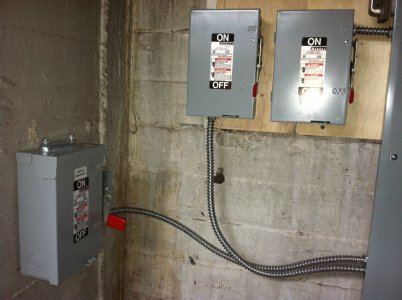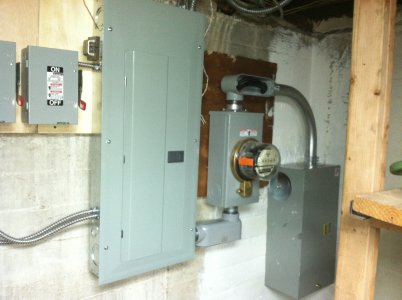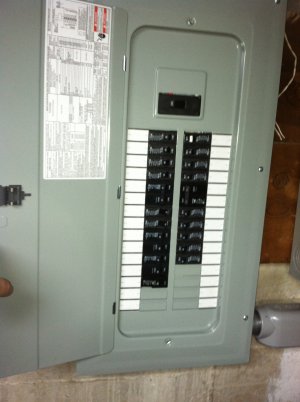-
Welcome back Guest! Did you know you can mentor other members here at H-M? If not, please check out our Relaunch of Hobby Machinist Mentoring Program!
You are using an out of date browser. It may not display this or other websites correctly.
You should upgrade or use an alternative browser.
You should upgrade or use an alternative browser.
The electrical service and disconnects are in
- Thread starter HMF
- Start date
- Joined
- Jun 17, 2011
- Messages
- 2,062
Looks good, Nelson.
While it's nice to have lots of power available, you are well advised to only use wire that can handle that current to feed a machine. A 30 amp breaker won't 'force' 30 amps into a load, but, if a fault occurs, it won't trip until the current exceeds 30 amps. If you used #16 wire (power cord, extension cord, etc.) to connect the machine, a couple of things could happen. As the load passes 8 or 10 amps, the voltage getting to the machine will drop and the too-thin wire will start to heat up. The heat will cause more resistance, increasing the losses and the heating.
If you will be using one of your disconnects to power a machine that carries a recommendation for a 20 amp breaker, just change the breaker. The wire will work just fine. For the record, never put a bigger breaker in than the wire is rated for. I find this all the time when I'm upgrading electrical services. I can usually tell withing the first few seconds when a non-electrician has been 'improving' things.
These comments are intended as general information for the benefit of anyone connecting equipment in his shop.
While it's nice to have lots of power available, you are well advised to only use wire that can handle that current to feed a machine. A 30 amp breaker won't 'force' 30 amps into a load, but, if a fault occurs, it won't trip until the current exceeds 30 amps. If you used #16 wire (power cord, extension cord, etc.) to connect the machine, a couple of things could happen. As the load passes 8 or 10 amps, the voltage getting to the machine will drop and the too-thin wire will start to heat up. The heat will cause more resistance, increasing the losses and the heating.
If you will be using one of your disconnects to power a machine that carries a recommendation for a 20 amp breaker, just change the breaker. The wire will work just fine. For the record, never put a bigger breaker in than the wire is rated for. I find this all the time when I'm upgrading electrical services. I can usually tell withing the first few seconds when a non-electrician has been 'improving' things.
These comments are intended as general information for the benefit of anyone connecting equipment in his shop.
- Joined
- Sep 22, 2010
- Messages
- 7,223
Looks good, Nelson.
While it's nice to have lots of power available, you are well advised to only use wire that can handle that current to feed a machine. A 30 amp breaker won't 'force' 30 amps into a load, but, if a fault occurs, it won't trip until the current exceeds 30 amps. If you used #16 wire (power cord, extension cord, etc.) to connect the machine, a couple of things could happen. As the load passes 8 or 10 amps, the voltage getting to the machine will drop and the too-thin wire will start to heat up. The heat will cause more resistance, increasing the losses and the heating.
We put in a 30A disconnect switch and 20A fuse and 30 A breaker with #10 wire. The electrician said the 20A breaker would trip the breaker sooner so you don't have to draw over 20 to trip it. I left it up to him.
I plan to use some 12/3 stranded in a rubber cable that I got from McMaster by the foot to go from the disconnect to the VFD and VFD to the motor. I probably should use some oilproof conduit over the stranded too, especially on the longer runs.
:tiphat:Nelson
- Joined
- Sep 22, 2010
- Messages
- 7,223
Looks like pretty decent work there.
I'm gonna second burnrider's recommendation; in two years you aren't going to remember what goes where, best to label them now before you get all the equipment in.
When I see what circuit turns off what, I will label them- it is required by code to pass inspection here.
Thanks,
:tiphat:Nelson
- Joined
- Feb 13, 2012
- Messages
- 340
Looks great Nelson------- always a big deal to get this part right.
Paul----they made me install one GFI line in my shop----funny how they come up with these rules. Septic tanks are a real big deal around here also ,they have a new young inspector.
Paul----they made me install one GFI line in my shop----funny how they come up with these rules. Septic tanks are a real big deal around here also ,they have a new young inspector.





